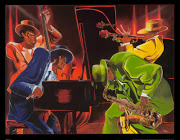[purchase solo works from Mike Auldridge here]
Like most players of the resophonic guitar - popularly called the Dobro, though as with Kleenex and Band-Aid, the term technically refers to a trademarked brand, originally coined by the instrument's inventor in 1928, and now produced exclusively by the Gibson corporation - Mike Auldridge got his start as a guitar player.
And to be honest, if he had remained a guitar player, we'd probably never have heard of him.
But while many who play the instrument treat it as an extension of their other fretwork, or treat it like a kind of overly-expensive slide guitar with high-tech acoustic innards (and play it that way), Auldridge saw something both unique and potent in the potential of the instrument as a lead voice, rather than just a session supplement. After Brother Oswald, who rescued the Dobro from obscurity with his work with Roy Acuff in the '40s and '50s, and after Auldridge's mentor Josh Graves came along and took the thing to another level as a bluegrass mainstay, Auldridge's subsequent pursuit of Dobro mastery, and his prodigious output on it both as a solo musician and as an integral part of the rising newgrass scene, with its fusion of bluegrass with jazz, folk and rock, brought the instrument to a new prominence in and beyond the bluegrass and country worlds.
In this, Auldridge joins a quite small group of musicians and craftspersons who almost single-handedly pushed their chosen instrument into a wholly new level of cultural and musical relevance. To say he made a huge splash as a musician in the last third of the 20th century is therefore both accurate, and a serious understatement of his impact on music.
That Auldridge's path to greatness - for himself, and for the Dobro - was so painstakingly slow is a tribute to his patience and his talent. For such recognition was neither easy nor instantaneous; indeed, although he was born in 1938, and was already playing the instrument by the fifties, Auldridge worked as a graphic designer full-time until well into the seventies, when his work with seminal newgrass group the Seldom Scene - a band which he co-founded in 1971 in the Maryland basement of banjo-player and mathematician Ben Eldridge - became popular enough to support full-time touring and recording.
Later, he would be a featured musician on albums by Emmylou Harris, Linda Ronstadt, and Patty Loveless, and found newgrass offshoot Chesapeake with several other Seldom Scene members when it became clear that the collaborative nature of the group would always be subservient to the leadership of John Duffey. He recorded numerous solo cuts and albums designed as instructional showpieces for the instrument, each of which sports great beauty and clarity while demonstrating the potential of the resophonic guitar as a lead instrument and voice. He won a Grammy for his work on The Dobro Sessions, and was named a National Endowment for the Arts Heritage Fellow in 2012. But although his solo work, as heard above, is quite beautiful, it is his work with The Seldom Scene for which he is best remembered, and as such, it is one of my favorite Seldom Scene songs which I have posted below in his honor today - check it out before we keep going, for both a clear shot at Duffey's camera-hogging approach to performance, and for Aldridge's solo, a wild ride which starts at 2:26, and lasts a full minute.
[purchase the Seldom Scene studio album of the same name]
Although choosing to stay in and around his native Maryland surely had some impact on his ability to spread the gospel of the Dobro, Auldridge famously never moved to Nashville, preferring even in his strongest decades to wait for others to invite him to tour and play on their records. But when he passed away just yesterday, he left a legacy nonetheless: one in which his own songs and sounds stand firm as a testament to greatness, and in which - thanks to his own work, and to his mentorship of other, younger masters of the instrument, such as Jerry Douglas and Rob Ickes - his chosen Dobro has become a core component of contemporary acoustic music, both as a central element of the bluegrass sound, and as a familiar staple in other related genres, from folk to country rock.






































































































































